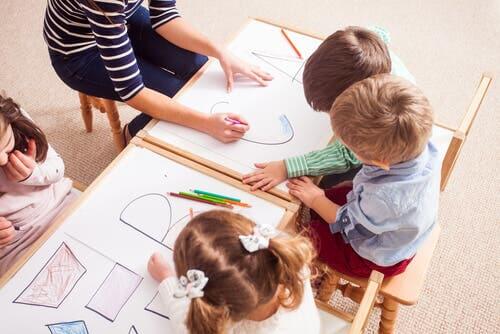Instructional Scaffolding in Education


Written and verified by the pedagogue and trainer María Matilde
Scaffolding in education is a strategy based on the need for support from teachers to ensure that students learn more and in a better way.
Both psychologist Lev Vygotsky and psychologist and pedagogue Jerome Seymour Bruner used the term “scaffolding” to explain how children can understand school content with the help of others. In fact, Bruner compared the construction of knowledge of people’s minds with that of buildings.
Origins of scaffolding in education
Theories and authors throughout history have tried to explain how people learn. Many of them state that the learning process is an interaction between the teacher and their students in order for the latter to understand and use knowledge, not only memorize it.
Thus, the different theories have used concepts and terms to explain how it is and how it should be, and what functions teachers and students must fulfill in the teaching-learning process. In this regard, experts conceive this process as active and capable of developing students’ capacities without considering them passive receivers of knowledge.

Lev Vygotsky, a Russian psychologist of Jewish origin, developed a learning theory in which one of its central concepts is that of ZPD, or zone of proximal development. This concept allowed Vygotsky to explain the distance between a student’s current level of development and their potential level of development. In other words, the distance between what a student can do on their own and what they’d be able to do with the help of a more capable adult or person.
In turn, in relation to the difference that exists between the two levels of competition called ZPD, Vygotsky used the term “scaffolding.” With the term “scaffolding,” the author explained, precisely, the temporary support that adults, parents, or teachers can provide children, so that they cross the zone of proximal development.
Vygotsky’s theory and his concepts of ZPD and scaffolding were later developed by authors such as Jerome Bruner.
Scaffolding in education: concept, goals, and functions
We already explained that the term “scaffolding” in the educational field refers to a form of temporary support that a teacher provides to their students. Strictly speaking, we could say, then, that scaffolding in education is a guided learning process. It’s a way to facilitate skill development.
The main goal in this guided form of learning is that students can progressively build cognitive structures and skills. And this wouldn’t be possible without a planned orientation and accompaniment from their educators. Scaffolding, therefore, aims to develop students’ self-regulatory capacity.
Considering its meaning and its goals, the functions that scaffolding in education fulfills are the following:
- Provides learning and homework help, accompaniment, information, guidance, and support.
- It motivates learning and reduces stress and frustration in the face of the unknown or apparently difficult.
- Also, it provides models for approaching contents that can be used with subsequent and new ones.
- It allows students to achieve goals that they couldn’t achieve autonomously.

Teacher’s role in scaffolding in education
You can’t forget that, in a learning process designed on the need for scaffolding, the student is the main protagonist. However, the teacher’s role is essential.
The teacher is responsible for planning the necessary scaffolding according to the specific learning activities. This makes it easier for students to understand the content in a significant way. Scaffolding can be the following:
- Firstly, support in the tasks, introducing new materials considering students’ previous knowledge.
- Motivation in the face of new challenges and learning.
- Also, activities that reinforce, expand, introduce, and clarify the knowledge that’s intended to be learned.
- Finally, diverse strategies to approach the contents, both for their reception, development, and production. We’re referring to: concept maps, charts, images, summaries, tables, graphs, glossaries, timelines, diagrams, etc.
In short, its main goal is for students to learn through the construction of their own knowledge. In this process, the teacher accompanies and guides them on the path to learning.
As Vygotsky expressed, “The teacher must adopt the role of facilitator, not content provider.”
Scaffolding in education is a strategy based on the need for support from teachers to ensure that students learn more and in a better way.
Both psychologist Lev Vygotsky and psychologist and pedagogue Jerome Seymour Bruner used the term “scaffolding” to explain how children can understand school content with the help of others. In fact, Bruner compared the construction of knowledge of people’s minds with that of buildings.
Origins of scaffolding in education
Theories and authors throughout history have tried to explain how people learn. Many of them state that the learning process is an interaction between the teacher and their students in order for the latter to understand and use knowledge, not only memorize it.
Thus, the different theories have used concepts and terms to explain how it is and how it should be, and what functions teachers and students must fulfill in the teaching-learning process. In this regard, experts conceive this process as active and capable of developing students’ capacities without considering them passive receivers of knowledge.

Lev Vygotsky, a Russian psychologist of Jewish origin, developed a learning theory in which one of its central concepts is that of ZPD, or zone of proximal development. This concept allowed Vygotsky to explain the distance between a student’s current level of development and their potential level of development. In other words, the distance between what a student can do on their own and what they’d be able to do with the help of a more capable adult or person.
In turn, in relation to the difference that exists between the two levels of competition called ZPD, Vygotsky used the term “scaffolding.” With the term “scaffolding,” the author explained, precisely, the temporary support that adults, parents, or teachers can provide children, so that they cross the zone of proximal development.
Vygotsky’s theory and his concepts of ZPD and scaffolding were later developed by authors such as Jerome Bruner.
Scaffolding in education: concept, goals, and functions
We already explained that the term “scaffolding” in the educational field refers to a form of temporary support that a teacher provides to their students. Strictly speaking, we could say, then, that scaffolding in education is a guided learning process. It’s a way to facilitate skill development.
The main goal in this guided form of learning is that students can progressively build cognitive structures and skills. And this wouldn’t be possible without a planned orientation and accompaniment from their educators. Scaffolding, therefore, aims to develop students’ self-regulatory capacity.
Considering its meaning and its goals, the functions that scaffolding in education fulfills are the following:
- Provides learning and homework help, accompaniment, information, guidance, and support.
- It motivates learning and reduces stress and frustration in the face of the unknown or apparently difficult.
- Also, it provides models for approaching contents that can be used with subsequent and new ones.
- It allows students to achieve goals that they couldn’t achieve autonomously.

Teacher’s role in scaffolding in education
You can’t forget that, in a learning process designed on the need for scaffolding, the student is the main protagonist. However, the teacher’s role is essential.
The teacher is responsible for planning the necessary scaffolding according to the specific learning activities. This makes it easier for students to understand the content in a significant way. Scaffolding can be the following:
- Firstly, support in the tasks, introducing new materials considering students’ previous knowledge.
- Motivation in the face of new challenges and learning.
- Also, activities that reinforce, expand, introduce, and clarify the knowledge that’s intended to be learned.
- Finally, diverse strategies to approach the contents, both for their reception, development, and production. We’re referring to: concept maps, charts, images, summaries, tables, graphs, glossaries, timelines, diagrams, etc.
In short, its main goal is for students to learn through the construction of their own knowledge. In this process, the teacher accompanies and guides them on the path to learning.
As Vygotsky expressed, “The teacher must adopt the role of facilitator, not content provider.”
All cited sources were thoroughly reviewed by our team to ensure their quality, reliability, currency, and validity. The bibliography of this article was considered reliable and of academic or scientific accuracy.
- Carrera, B., Mazzarella, C. (2001). Vygotsky: enfoque sociocultural. Educere, 5(13), pp. 41-44. Recuperado de https://www.redalyc.org/pdf/356/35601309.pdf
- Vargas, O. L., Martínez, C. H., Uribe, Á. C. (2012). Logro de aprendizaje en ambientes hipermediales: andamiaje autorregulador y estilo cognitivo. Revista latinoamericana de psicología, 44(2), pp. 13-26. Recuperado de http://www.scielo.org.co/pdf/rlps/v44n2/v44n2a01.pdf#page=13
- López Vargas, O., Hederich Martinez, C. (2010). Efecto de un andamiaje para facilitar el aprendizaje autorregulado en ambientes hipermedia. Revista Colombiana de Educación. Universidad Pedagógica Nacional. Bogotá Colombia. Núm. 58, pp. 14-39. Recuperado de https://www.redalyc.org/pdf/4136/413635664002.pdf
This text is provided for informational purposes only and does not replace consultation with a professional. If in doubt, consult your specialist.








